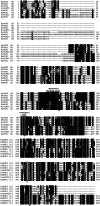Plasmodium chitinases: revisiting a target of transmission-blockade against malaria
- PMID: 33934433
- PMCID: PMC8284580
- DOI: 10.1002/pro.4095
Plasmodium chitinases: revisiting a target of transmission-blockade against malaria
Abstract
Malaria is a life-threatening disease caused by one of the five species of Plasmodium, among which Plasmodium falciparum cause the deadliest form of the disease. Plasmodium species are dependent on a vertebrate host and a blood-sucking insect vector to complete their life cycle. Plasmodium chitinases belonging to the GH18 family are secreted inside the mosquito midgut, during the ookinete stage of the parasite. Chitinases mediate the penetration of parasite through the peritrophic membrane, facilitating access to the gut epithelial layer. In this review, we describe Plasmodium chitinases with special emphasis on chitinases from P. falciparum and P. vivax, the representative examples of the short and long forms of this protein. In addition to the chitinase domain, chitinases belonging to the long form contain a pro-domain and chitin-binding domain. Amino acid sequence alignment of long and short form chitinase domains reveals multiple positions containing variant residues. A subset of these positions was found to be conserved or invariant within long or short forms, indicating the role of these positions in attributing form-specific activity. The reported differences in affinities to allosamidin for P. vivax and P. falciparum were predicted to be due to different residues at two amino acid positions, resulting in altered interactions with the inhibitor. Understanding the role of these amino acids in Plasmodium chitinases will help us elucidate the mechanism of catalysis and the mode of inhibition, which will be the key for identification of potent inhibitors or antibodies demonstrating transmission-blocking activity.
Keywords: Anopheles; Plasmodium; allosamidin; chitinase; malaria; transmission-blocking.
© 2021 The Protein Society.
Conflict of interest statement
All authors have no conflicts of interest to declare relevant to this study.
Figures




Similar articles
-
The chitinase PfCHT1 from the human malaria parasite Plasmodium falciparum lacks proenzyme and chitin-binding domains and displays unique substrate preferences.Proc Natl Acad Sci U S A. 1999 Nov 23;96(24):14061-6. doi: 10.1073/pnas.96.24.14061. Proc Natl Acad Sci U S A. 1999. PMID: 10570198 Free PMC article.
-
Chitinases of the avian malaria parasite Plasmodium gallinaceum, a class of enzymes necessary for parasite invasion of the mosquito midgut.J Biol Chem. 2000 Apr 7;275(14):10331-41. doi: 10.1074/jbc.275.14.10331. J Biol Chem. 2000. PMID: 10744721
-
Enzymatic characterization of the Plasmodium vivax chitinase, a potential malaria transmission-blocking target.Parasitol Int. 2009 Sep;58(3):243-8. doi: 10.1016/j.parint.2009.05.002. Epub 2009 May 8. Parasitol Int. 2009. PMID: 19427918 Free PMC article.
-
Plasmodium ookinete-secreted chitinase and parasite penetration of the mosquito peritrophic matrix.Trends Parasitol. 2001 Jun;17(6):269-72. doi: 10.1016/s1471-4922(01)01918-3. Trends Parasitol. 2001. PMID: 11378031 Review.
-
Plasmodium: parasite chitinase and its role in malaria transmission.Exp Parasitol. 1994 Aug;79(1):85-8. doi: 10.1006/expr.1994.1066. Exp Parasitol. 1994. PMID: 7914174 Review. No abstract available.
Cited by
-
Plasmodium falciparum Development from Gametocyte to Oocyst: Insight from Functional Studies.Microorganisms. 2023 Jul 31;11(8):1966. doi: 10.3390/microorganisms11081966. Microorganisms. 2023. PMID: 37630530 Free PMC article. Review.
-
Susceptibility of Field-Collected Nyssorhynchus darlingi to Plasmodium spp. in Western Amazonian Brazil.Genes (Basel). 2021 Oct 25;12(11):1693. doi: 10.3390/genes12111693. Genes (Basel). 2021. PMID: 34828299 Free PMC article.
-
The impact of three thioxothiazolidin compounds on trehalase activity and development of Spodoptera frugiperda larvae.PeerJ. 2024 Oct 9;12:e18233. doi: 10.7717/peerj.18233. eCollection 2024. PeerJ. 2024. PMID: 39399419 Free PMC article.
-
The phosphatase inhibitor BVT-948 can be used to efficiently screen functional sexual development proteins in the malaria parasite Plasmodium berghei.Int J Parasitol Drugs Drug Resist. 2024 Dec;26:100563. doi: 10.1016/j.ijpddr.2024.100563. Epub 2024 Aug 14. Int J Parasitol Drugs Drug Resist. 2024. PMID: 39153438 Free PMC article.
-
Mosquito immune responses to Plasmodium parasites that limit malaria transmission.Cell Mol Life Sci. 2025 Apr 7;82(1):143. doi: 10.1007/s00018-025-05667-z. Cell Mol Life Sci. 2025. PMID: 40192851 Free PMC article. Review.
References
-
- Who.int, 2021 . World malaria report 2020. https://www.who.int/publications/i/item/9789240015791.
Publication types
MeSH terms
Substances
LinkOut - more resources
Full Text Sources
Other Literature Sources

